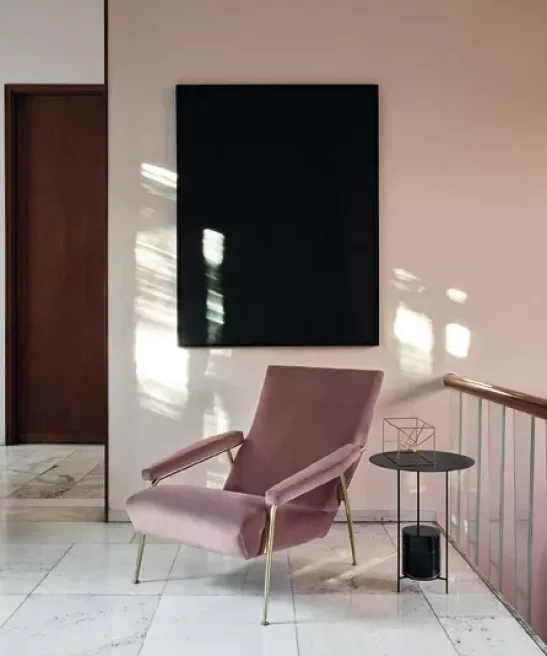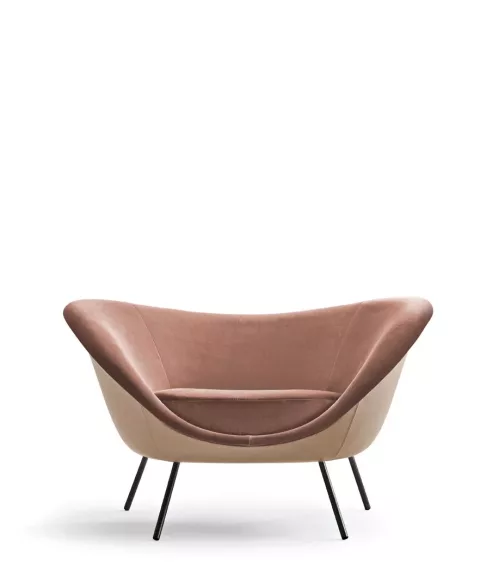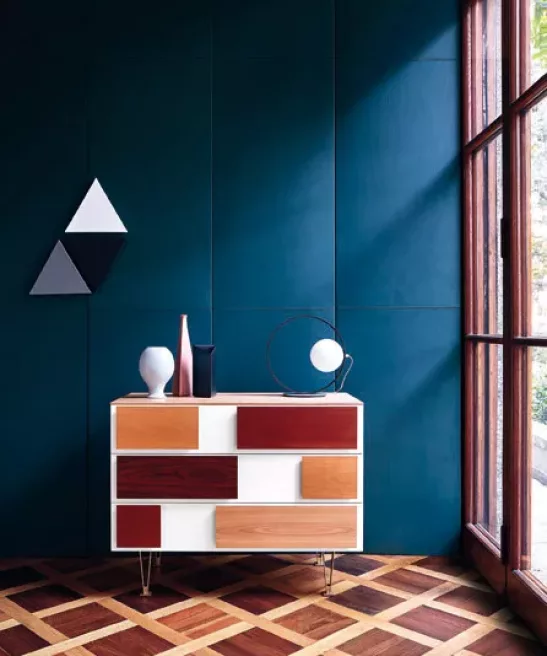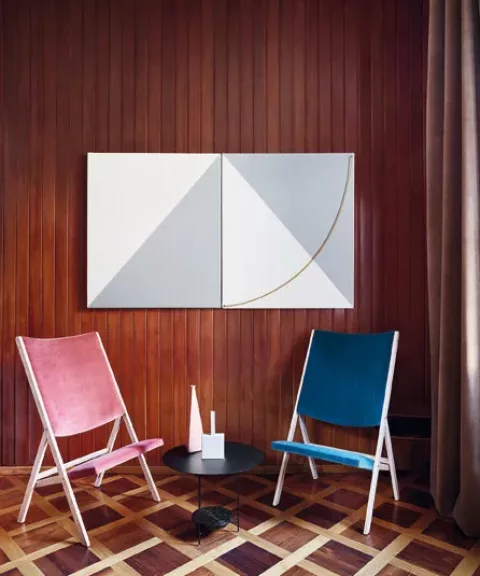Associated with the great works of architecture that bear his incomparable signature is vast production in the furniture sector, also testified by his three Milanese dwellings, entirely decorated “à la Ponti”: that of via Randaccio in 1925, Casa Laporte via Brin in 1926, and the last, via Dezza in 1957, “manifest” of its domestic design.
Gio Ponti, promoter of Italian industrial design, proposed mass production in the layout of interiors as a “sophisticated”, economical, “democratic” and modern solution.
Gio Ponti graduated in Architecture at the Polytechnic University of Milan at the end of the First World War, where he participated on the front lines, which earned him some decorations on the field. In 1921 he married Giulia Vimercati, with whom he had four children: Lisa, Giovanna, Letizia and Giulio.
In 1927 he opened his agency in Milan with the architect Emilio Lancia. From the beginning of the 1920s and until 1938, he collaborated with the Manufacturer Richard-Ginori and renewed its production. In 1928 he founded Domus magazine with Gianni Mazzocchi. In 1933 he assumed the artistic direction of Fontana Arte, another success after the one obtained with Richard-Ginori.
In the 1930s, he took part in the Milan Triennials, which offered international exhibitions, conferences and artistic events around design, fashion, architecture and cinema, and took care of a few editions with dazzling success.
From 1936 to 1961 he was a professor at the Polytechnic University of Milan, and in 1933 he associated with Antonio Fornaroli and Eugenio Soncini until 1945. Large projects were born from this association, such as the Palazzo Montecatini in Milan (1936-1938) for which Ponti carried out the integral design of the building and the interiors, among others. Then followed civil architectural projects, such as the Torre Littoria in Milan (1933), school buildings, such as the School of Mathematics at the University City of Rome (1934), the Faculty of Letters and the Rectorate of the University of Padua (1937), and residential projects like Casa Marmont (1934) and the “Domus” (1931-1936) in Milan, among others.
In 1941 he left the management of Domus and founded Stile magazine. In 1952 the Ponti-Fornaroli-Rosselli Firm was born and in 1954 he became co-founder, with Alberto Rosselli, of Stile Industria magazine.
In the 1950s Ponti experienced “a new creative youth”. This is evidenced by the second Palazzo Montecatini (1951), the fittings of the transatlantic “Andrea Doria” (1952), the interiors and the swimming pool of the Royal Hotel in Naples (1953), the Italian Institute of Culture in Stockholm (1954), the villas in Caracas, Villa Planchart (1955) and Villa Areazza (1956), and in Tehran, Villa Nemazee (1960). In 1956 he created his masterpiece: the Pirelli Tower in Milan.
In the 1960s he travelled to the Orient where he designed the ministerial buildings of Islamabad in Pakistan (1964) and the facade of the Shui-Hing department stores in Hong Kong (1963). In those same years, he designed the Parco dei Principi Hotel in Sorrento (1960) and Rome (1964), and the Churches of San Francesco (1964) and San Carlo Borromeo (1966) in Milan.
In the ‘70s and ‘80s Gio Ponti still produced important architectures such as the co-cathedral of Taranto (1970) and the Museum of Denver (1971), and later furniture, such as “the Gabriela armchair with the reduced seat” of 1971.


The reissue project, initiated by the furniture brand Molteni&C, gave life to a collection of furniture, including some models designed by Ponti only in unique pieces or in limited series, presented for the first time at the Milan Furniture Fair in 2012, after a long process of research, selection and study of prototypes.
The collection, produced in collaboration with the Gio Ponti Archives and the artistic direction of the Cerri & Associati Firm, includes furniture and accessories designed by Gio Ponti between 1935 and the 1970s, which are now part of the Heritage Collection by Molteni&C. The design and materials conform to the original documents kept at the Gio Ponti Archive and the CSAC – Centre for Studies and Communication Archives of the University of Parma.
Over the years new pieces have enriched the collection, which today includes around fifteen pieces of furniture in different variations.
The Heritage Collection
The Montecatini chair
Designed in 1935 for the first Montecatini Palace in Milan. It is made entirely of polished aluminium or covered in saddle leather.
D.270.1 and D.270.2 Folding chairs and armchairs
Folding chairs and armchairs from the Apta series presented in 1970 at the Eurodomus 3 exhibition in Milan.
D.655.1 and D.655.2 Chests of drawers
Designed in several variants between 1952 and 1955. They are distinguished by the hand-painted drawer fronts, with handles in different woods. The elm wood structure is supported by satin brass legs.
D.555.1 and D.555.2 Coffee tables
D.555.1 is a round model, designed between 1954 and 1955. Hand-painted. D.555.2 is a triangular model in rosewood with satin brass legs and a glass top. It was designed in the 1950s for the M. Singer&Sons company, one of the largest in New York.
D.357.1 and D.357.2 Bookshelves
Designed between 1956 and 1957 for the Ponti residence, via Dezza, in Milan. Made of shaped “plywood” covered with elm.
D.859.1 Table
Originally designed by Ponti in 1959 for the Auditorium of the Time&Life Building in New York, the table is available either in the original version or in black stained ash.


The true Architect should fall in love, for each house he builds or decorates, with the inhabitants.
Everyday architecture
The exhibition “Vivere alla Ponti” was presented at the Lab of the RBC Paris showroom, from 29 November 2018 to 28 February 2019.
Organised by Francesca Molteni and Franco Raggi in collaboration with Salvatore Licitra, the Gio Ponti Archive, the Association of Architects of Milan and the Molteni Museum, the exhibition “Vivere Alla Ponti” presented the architectural experiences of Gio Ponti, from his industrial buildings right up to his furniture creations.
This retrospective paid tribute to the master of the 20th century, to his passion for interior design, his obsession with detail and his vision of modernity still relevant today. In “Vivere alla Ponti”, the interior design projects of the master – houses and offices – come to life thanks to numerous archival photographs and drawings, some of which have never been seen before, made during his lifetime.
In resonance with the “Tutto Ponti” exhibition presented at MAD in 2018, RBC Paris offered reissues of furniture designed by Gio Ponti and produced by Molteni&C, staged by Francesca Molteni and Franco Raggi.
Constructed as a dialogue with the designer, an encounter between art and industry illustrated by the presentation of the furniture collections, the exhibition placed the architectural, industrial and domestic works of the famous architect in abyss.
The exhibition route, under the glass roof on the first floor, retraced his works to his work environment projects, such as the desks of the Montecatini Palace in Milan, the very famous Pirelli desks or the furniture of the company Vhembe -Burroughs where the “pin-ups” of the ‘50s stroll.
The places designed by Gio Ponti are designed for living there, for the happiness of the children, for the comfort of the employees, for the efficiency of the work. They are real places where architecture, interior design and furniture integrate harmoniously.
